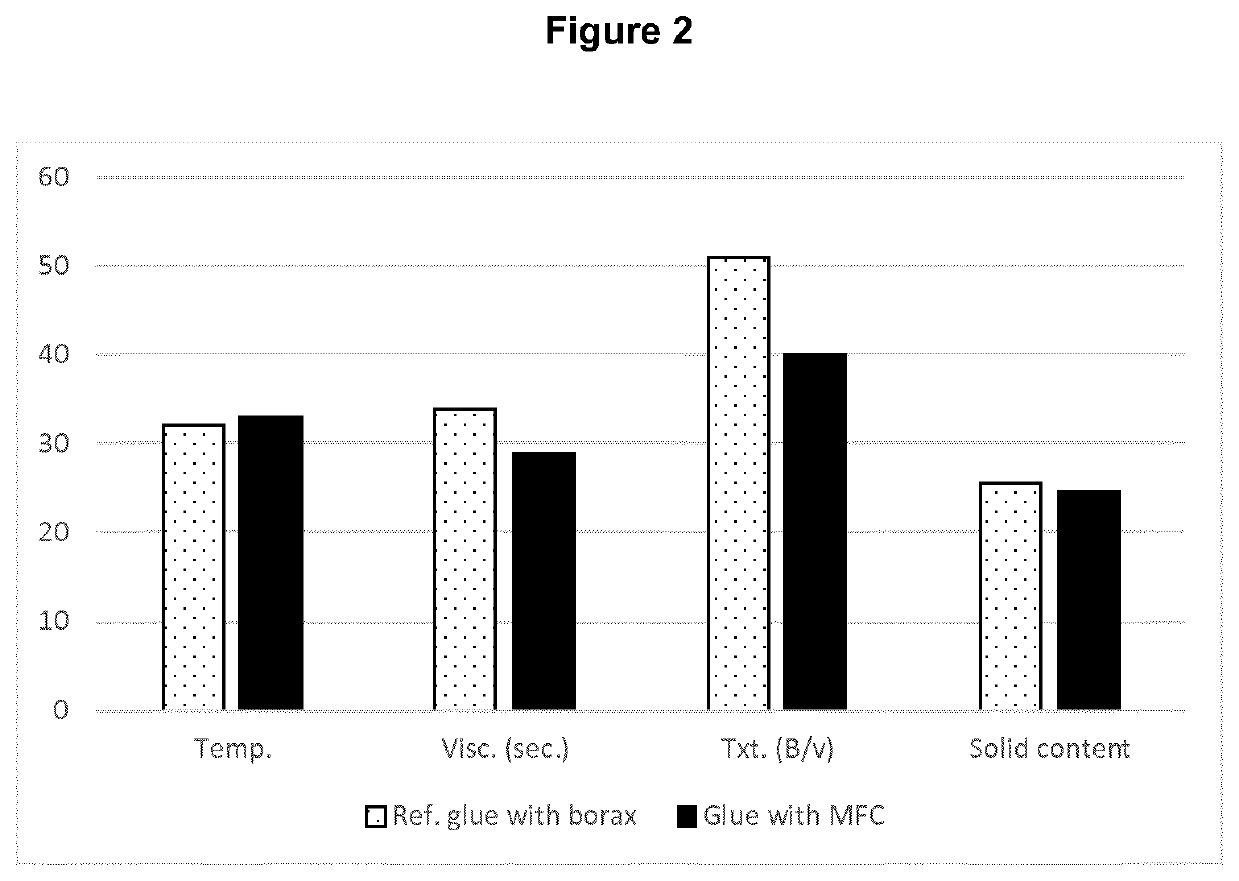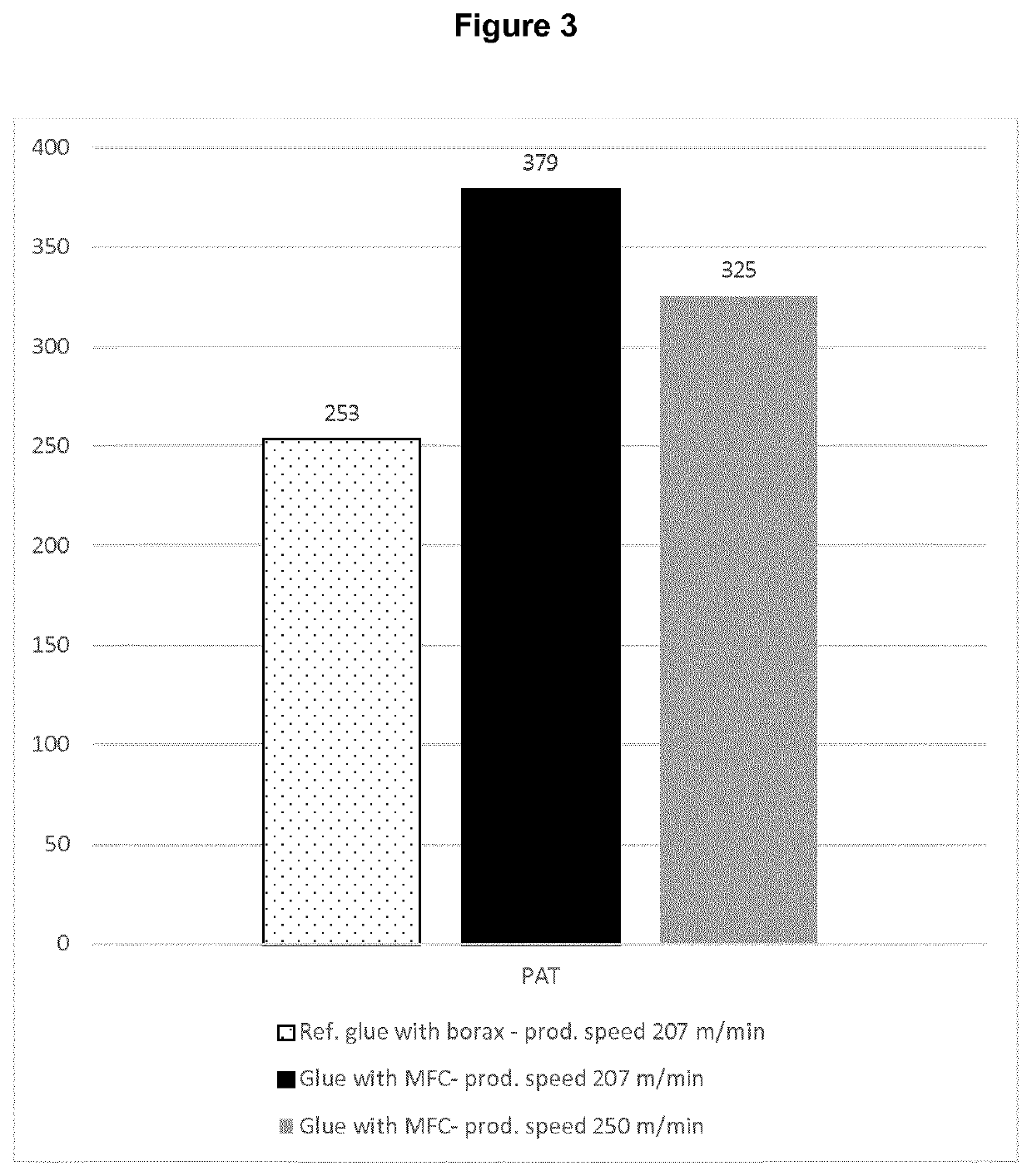Microfibrillated cellulose as a crosslinking agent
a technology of microfibrillated cellulose and crosslinking agent, which is applied in the direction of cellulose coating, unsaturated alcohol polymer adhesive, fibreboard, etc., can solve the problems of increasing or undesirable levels of toxicity, and achieve the effect of improving rheological profile, high water retention capacity and suitable application
- Summary
- Abstract
- Description
- Claims
- Application Information
AI Technical Summary
Benefits of technology
Problems solved by technology
Method used
Image
Examples
example 1
Preparation of Microfibrillated Cellulose
[0130]MFC as in the compositions of the present invention is commercially available and commercialized, for example, by Borregaard as “Exilva Microfibrillated cellulose PBX 01-V”, based on cellulose pulp from Norwegian spruce (softwood). Exemplary processes to obtain this MFC are described, among others in PCT / EP2015 / 001103 (WO 2015 / 180844). The disclosure of this earlier application is made part of the disclosure of the present invention in the context of any process for manufacturing MFC.
[0131]The MFC used in the examples is present as a paste, having a solids content of 10% (for the examples, in which microfibrillated cellulose is used as a cross-linker in starch-based adhesives) and 2% (for the examples, in which microfibrillated cellulose is used to cross-link PVA). The solvent was water.
example 2
Preparation of an Adhesive Comprising Microfibrillated Cellulose
[0132]The process for preparing a starch based corrugated paperboard adhesive, cross-linked by MFC, is given below. The viscosities at different process steps were measured online by a viscometer, and controlled manually by measuring the Lory viscosity.
[0133]An adhesive in accordance with the present invention was prepared based on the following ingredients and manufactured according to the following steps:[0134]750 kg of primary water[0135]180 kg of primary wheat starch
Stirring for 30 sec at a temperature of 36.5° C.[0136]100 kg of water[0137]16.5 kg Primary caustic soda[0138]80 kg of water
Stirring for 30 sec
[0139]Viscosity control value 1 is set to: 10 sec
Stirring for 840 sec
[0140]Viscosity control 2: 33.8 sec[0141]260 kg secondary water[0142]Disinfectant: 0.4 kg
Temperature 35° C.
[0143]280 kg secondary wheat starch
Stirring for 30 sec
[0144]20 kg of MFC (Exilva PBX 01-V)
Stirring for 600 sec
[0145]21 kg of water
Viscosity ...
example 3
Preparation of a Starch Based Adhesive Comprising Borax (Reference)
[0151]A reference adhesive was prepared based on the following ingredients and manufactured according to the following steps:[0152]750 kg of primary water[0153]180 kg of primary wheat starch
Stirring for 30 sec, temperature 36.5° C.[0154]100 kg of water[0155]16.5 kg Primary caustic soda[0156]80 kg of water
Stirring for 30 sec
[0157]Viscosity control 1: 10 sec
Stirring for 840 sec
[0158]Viscosity control 2: 33.8 sec[0159]260 kg secondary water[0160]Disinfectant: 0.4 kg
Temperature 35° C.
[0161]280 kg secondary wheat starch
Stirring for 30 sec
[0162]2.5 kg of borax
Stirring for 600 sec
[0163]Viscosity control 3, final: 28 sec
The pH of the final adhesive was 11.7.
[0164]Borax is added, after the addition and inmix of the secondary unswollen starch. The concentration of borax in the final formulation was 0.15%. The Lory viscosity of the starch adhesive with borax was decreasing readily with mixing time at high shear.
PUM
| Property | Measurement | Unit |
|---|---|---|
| zero shear viscosity | aaaaa | aaaaa |
| zero shear viscosity | aaaaa | aaaaa |
| zero shear viscosity | aaaaa | aaaaa |
Abstract
Description
Claims
Application Information
 Login to View More
Login to View More - R&D
- Intellectual Property
- Life Sciences
- Materials
- Tech Scout
- Unparalleled Data Quality
- Higher Quality Content
- 60% Fewer Hallucinations
Browse by: Latest US Patents, China's latest patents, Technical Efficacy Thesaurus, Application Domain, Technology Topic, Popular Technical Reports.
© 2025 PatSnap. All rights reserved.Legal|Privacy policy|Modern Slavery Act Transparency Statement|Sitemap|About US| Contact US: help@patsnap.com



